Hawaiian hibiscus are seven species of hibiscus native to Hawaii. The yellow hibiscus is Hawaii's state flower. Most commonly grown as ornamental plants in the Hawaiian Islands are the non-native Chinese hibiscus and its numerous hybrids, though the native Hibiscus arnottianus is occasionally planted.
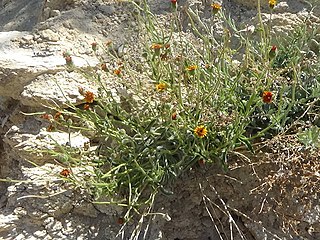
Hulsea vestita is a species of flowering plant in the family Asteraceae known by the common name pumice alpinegold.

Solidago nemoralis is a species of flowering plant in the family Asteraceae. It is native to North America, where it is widely found in Canada and the United States. Its common names include gray goldenrod, gray-stem goldenrod, old-field goldenrod, field goldenrod, prairie goldenrod, dwarf goldenrod, and dyersweed goldenrod.
Pentachaeta exilis is a species of flowering plant in the family Asteraceae known by the common name meager pygmydaisy. It is endemic to California, where it is known from the North Coast Ranges to the southern Central Valley, San Joaquin Valley, and Sierra Nevada foothills. It is a member of grassland and woodland plant communities.

Euphorbia kuwaleana is a rare species of flowering plant in the euphorb family known by the common name kokomalei. It is endemic to Oahu, Hawaii, where it is known only from a four-kilometer stretch of the Waianae Range. Like other Hawaiian euphorbs, this plant is known locally as `akoko. It is a federally listed endangered species of the United States.

Cyanea grimesiana is a rare species of flowering plant in the bellflower family known by the common name splitleaf cyanea. It is native to Oahu and Molokai, where it is known from 12 occurrences. It is a federally listed endangered species. Like other Cyanea it is known as haha in Hawaiian.
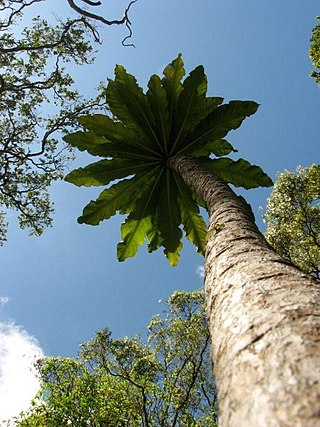
Cyanea superba is a rare species of flowering plant in the bellflower family known by the common names Mt. Kaala cyanea and superb cyanea. It is endemic to the island of Oahu, but it is now extinct in the wild. It exists in cultivation and some individuals have been planted in appropriate habitat. It is a federally listed endangered species of the United States. Like other Cyanea it is known as haha in Hawaiian.

Kadua parvula is a rare species of flowering plant in the coffee family known by the common name rockface star-violet. It is endemic to Hawaii, where it is known only from the Waianae Mountains on the island of Oahu. It is a federally listed endangered species of the United States.
Lobelia gaudichaudii is a species of flowering plant in the bellflower family known by the common name Koolau Range lobelia. It is endemic to Hawaii, where it is known only from the island of Oahu.

Cyperus pennatiformis is a rare species of sedge known by the common name coastal flatsedge. It is endemic to Hawaii, where it grows on the islands of Maui, Kauai, and Laysan. It is a federally listed endangered species of the United States.
Phyllostegia hirsuta is a species of flowering plant in the mint family known by the common names Molokai phyllostegia and hairy phyllostegia. It is endemic to Hawaii, where it is known only from the island of Oahu. It is a federally listed endangered species of the United States.
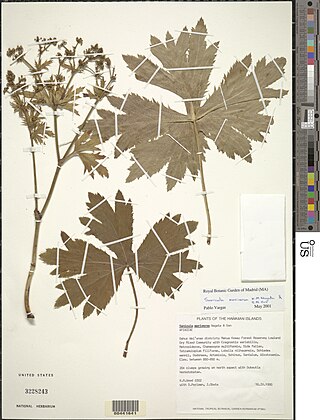
Sanicula mariversa is a rare species of flowering plant in the family Apiaceae known by the common name Waianae Range black-snakeroot. It is endemic to Hawaii, where it is known only from the Waianae Mountains on the island of Oahu. It is threatened by the degradation of its habitat. It is a federally listed endangered species of the United States.

Schiedea hookeri is a rare species of flowering plant in the family Caryophyllaceae known by the common names Hooker's schiedea and sprawling schiedea. It is endemic to Hawaii, where it is known only from the island of Oahu. It is thought to have been extirpated from Haleakalā on Maui. It is threatened by the degradation and destruction of its habitat. It was federally listed as an endangered species of the United States in 1996.
Schiedea kealiae is a rare species of flowering plant in the family Caryophyllaceae known by the common name Waianae Range schiedea. It is endemic to Hawaii, where it is known only from the Waianae Range on the island of Oahu. It is threatened by the degradation and destruction of its habitat. It was federally listed as an endangered species of the United States in 1996.
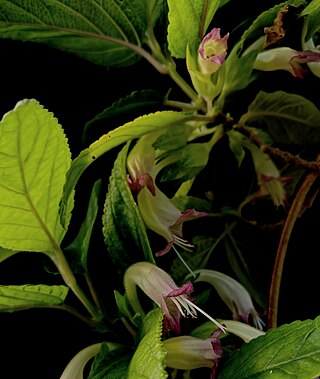
Stenogyne kanehoana is a rare species of flowering plant in the mint family known by the common name Oahu stenogyne. It is endemic to Hawaii, where it is known only from the Waianae Range on the island of Oahu. It is a federally listed endangered species of the United States.
Tetramolopium arenarium is a rare species of flowering plant in the family Asteraceae known by the common name Maui tetramolopium. It is endemic to Hawaii, where it is known only from the island of Hawaii. It is extirpated from Maui. It is threatened by the degradation of its habitat. It is a federally listed endangered species of the United States.
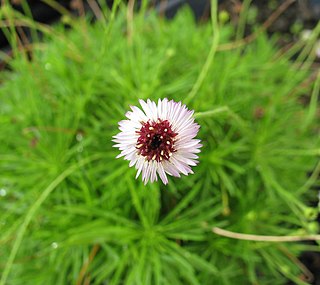
Tetramolopium filiforme is a rare species of flowering plant in the family Asteraceae known by the common name ridgetop tetramolopium. It is endemic to Hawaii, where it is known only from the Waianae Mountains on the island of Oahu. It is threatened by habitat degradation caused by feral goats and introduced species of plants. It is a federally listed endangered species of the United States.
Tetramolopium remyi is a rare species of flowering plant in the family Asteraceae known by the common names Awalua Ridge tetramolopium and Remy's tetramolopium. It is endemic to Hawaii, where today it is known only from the island of Lanai. It is believed to be extirpated on the island of Maui, having not been observed there since 1944. It is threatened by habitat degradation caused by deer, Mouflon, and introduced species of plants. It is a federally listed endangered species of the United States.

Viola chamissoniana is a species of flowering plant in the violet family known by the common name 'olopu. It is endemic to Hawaii, where it is known from the islands of Kauai, Oahu, Molokai, and Maui.
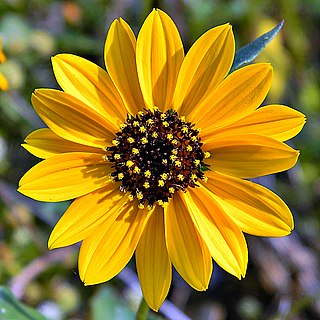
Helianthus debilis is a species of sunflower known by the common names cucumberleaf sunflower, beach sunflower, weak sunflower, and East Coast dune sunflower. It is native to the United States, where it can be found along the Atlantic and Gulf Coasts. It is known elsewhere as an introduced species, such as South Africa, Australia, Taiwan, Slovakia, and Cuba.














